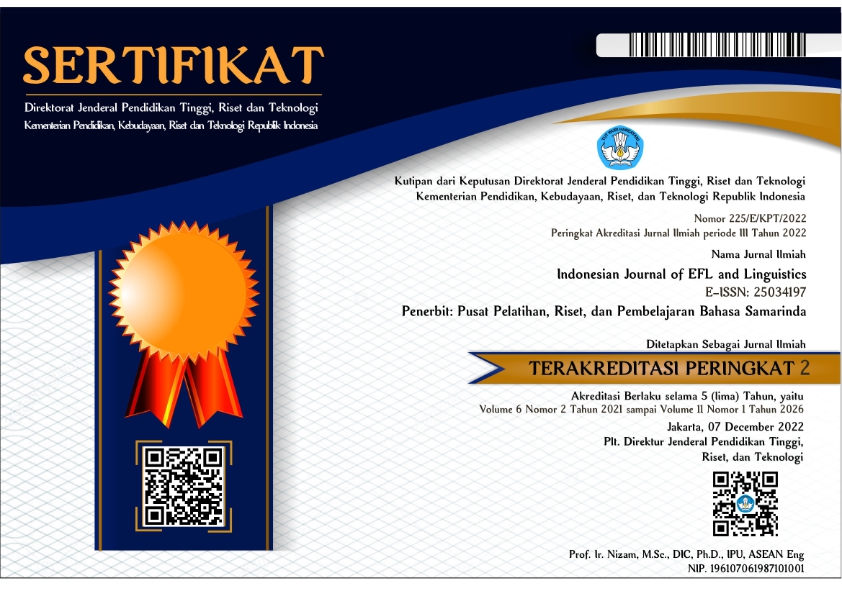Conjunctive Relation in English Advertisement on Child and Teen Magazines
Abstract
There are many previous types of research about semiotics, language style and image in analyzing advertisements. This study analyzes advertisements by conjunctive relations. This is aimed at observing how the conjunctive relation analyzing the advertisement and constructing the meaning to target readers. This study describes the use of conjunctive relation that results from different stages in the advertisement. The data used advertisements published from August â€" September 2018 in Junior and Teen Magazine. The method of this study is descriptive qualitative. This study used purposive based sampling based on the objectives of the study. In analyzing data, researchers use Systemic Functional Linguistics approach. This step of analysis uses a domain, taxonomy, componential and cultural theme analysis. The study finds out that the advertisement is structured by exposition genre and the message is delivered well to specific target readers; children or teenagers. Besides,conjunctive relation’s analysis finds the invitation meaning explicitly. In conclusion, the language and meaning are easy to understand both the target readers.
References
Ali, M. M. (2014). Analisis isi iklan televisi di indonesia. HUMANIORA, 5(45), 766–776.
Arifah, N., Djatmika, & Santosa, R. (2019). The Texture of Macro and Micro Genre on Advertisement in C ’ nS Magazine, 279(Icalc 2018), 281–286.
Asror, A. G. (2015). Bahasa Pencitraan Dalam Iklan Kampanye Pilkada Kabupaten Bojonegoro, (92), 24–34.
Belk, R. W. (2017). Qualitative Research in Advertising. Journal of Advertising, 0(0). https://doi.org/10.1080/00913367.2016.1201025
Eman, A. K. U. (2018). The Study of Grice Principle in Pakistani Advertisements. International Journal of Linguistics, Literature and Translation, 1(3), 43–50.
Flergin, A. (2014). Language of Persuasion : A Discourse Approach to Advertising Language, 3, 62–68.
Frith, K. T., & Mueller, B. (2003). Advertising and Societies : Global Issues. New York: Peter Lang.
Håkansson, A., & Widingho, C. (2019). Television gambling advertisements : Extent and content of gambling advertisements with a focus on potential high-risk commercial messages. Addictive Behaviorals Reports, 9(April). https://doi.org/10.1016/j.abrep.2019.100182
Halliday, M. A. . (1994). An Introduction to Functional Grammar (Second). London: Edward Arnold.
Halliday, M. A. . (2003). On Language and Linguistics. (J. Webster, Ed.). London: Continuum.
Kleppner, O. (1992). Advertising Procedure. New York: Prentice-Hall.
Lacia, K., Ginco, J. N., Marie, R., & Maxilom, R. (2019). Interactional Strategies and Anaphoric Repairs of BS Information and Communications ( BSIT ) Technology Students. Indonesian Journal of EFL and Linguistics, 4(1), 89–107.
Lole, L., Li, E. N., Russell, A. M., Greer, N., Thorne, H., & Hing, N. (2019). Are sports bettors looking at responsible gambling messages ? An eye-tracking study on wagering advertisements. Journal of Behavioral Addictions. https://doi.org/10.1556/2006.8.2019.37
Machfoedz, M. (2010). Komunikasi Pemasaran Modern. Yogyakarta: Cakra Ilmu.
Manarul, A. (2019). Teks Iklan : Pengertian, Struktur, Contoh. Retrieved September 17, 2019, from https://www.yuksinau.id/teks-iklan-pengertian-struktur-contoh/
Mansor, N. S., Mamat, R., Omar, R. C., & Ghazali, A. H. A. (2014). Ketidaksantunan Bahasa Sebagai Strategi Pujukan dalam Iklan Berbahasa Sepanyol. GEMA Online Journal of Language Studies, 14(3). https://doi.org/10.17576/GEMA-2014-1403-13
Martin, J. R. and D. R. (2003). Working With Discourse : Meaning Beyond The Clause. London: Continuum.
Martin, J. R. and D. R. (2007). Working with Discourse: Meaning Beyond The Clause. London: Continuum.
Noar, S. M., Rohde, J. A., Horvitz, C., Lazard, A. J., Ross, J. C., & Sutfin, E. L. (2018). Adolescents’ Receptivity to E-cigarette Harms Messages Delivered using Text Messaging. Addictive Behaviors. https://doi.org/10.1016/j.addbeh.2018.05.025
Pand, Y. R., & Gui, W. (2016). Influence of Advertisement Message on Fitbar Billboard towards Brand Awareness and Its Implication to Brand Image. HUMANIORA, 1(7), 63–76.
Perez-Sobrino, P., Littlemore, J., & Houghton, D. (2018). The Role of Figurative Complexity in the Comprehension and Appreciation of Advertisements. Applied Linguistics, 1–36. https://doi.org/10.1093/applin/amy039
Reid, I. (1987). The Place of Genre in Learning: Current Debates. : Center for Studies in Literary Education: Deakin University.
Santosa, R. (2003). Semiotika Sosial Pandangan Terhadap Bahasa (1st ed.). Surabaya: Pustaka Eureka dan JP Press Surabaya.
Santosa, R. (2010). Logika Wacana: Analisis Hubungan Konjungtif dengan Pendekatan Linguistik Sistemik Fungsional. Surakarta: LPP UNS dan UNS Press.
Schwab, V. O. (1962). How to Write a Good Advertisement. New York: Harper & Row.
Serrano, M. J. (2018). The Construction of Advertising Discourse by the Use of the Second-Person Object Te and the Clitic Se. De Gruyter, 6(2), 173–196. https://doi.org/https://doi.org/10.1515/soprag-2018-0005
SolÃk, M. (2014). Semiotic approach to analysis of advertising. European Journal of Science and Theology, 10(October), 207–217.
Tjitrakusuma, N. I. (2016). Metaphorical Expressions Used in Foods Products Advertisements and Their Inferences. K@ta, 18(1), 13–18. https://doi.org/10.9744/kata.18.1.13-18
Well, W., Moriarty, S., & Burnett, J. (2006). Advertising Principle and Practice. United States of America: Pearson Prentice Hall.
Wisudawati, A. F., & Setyani, N. I. (2018). Critical Discourse Analysis of Global Warming Public Service Advertisement : Implication for Students. EduLite, 3, 149–160. https://doi.org/http://dx.doi.org/10.30659/e.3.2.149-160
Wong, M. (2019). The Discourse of Advertising for Luxury Residences in Hong Kong : A Multimodal Critical Discourse Analysis. Multimodal Communication, 107–130. https://doi.org/10.1007/978-3-030-15428-8
Zhu, J. (2017). A Study on Culture Adaptation Difference between Chinese and American Advertising Discourses. English Language and Literature Studies, 7(4), 58–65. https://doi.org/10.5539/ells.v7n4p58




